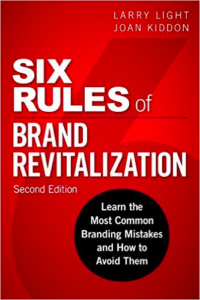6 Rules of Brand Revitalization
How do you keep a brand relevant?
If you are looking to develop a strong global brand, you will find two names consistently mentioned as “go-to” experts: Larry Light and Joan Kiddon. They have just released a second edition of their book on branding, Six Rules of Brand Revitalization.
If you need to revitalize a brand, or if you are looking to avoid the pitfalls others have made, this book is a blueprint to follow for building a brand.
I recently spoke with the authors about their new book and the rules of branding.
6 Rules of Brand Revitalization
Where do most corporate leaders get it wrong?
They tend to believe that “refocus” can happen through tools and templates and HR seminars. Refocus is more than filling in the blanks and talking the talk. When there is a conflict between strategy and culture, culture wins. A commitment to change requires refocusing of the cultural mindset that emanates from the top down. Merely embarking on a training program to encourage a focus on new tools, templates, and techniques can distract from the need to accomplish both the behavioral and attitudinal modifications that foster culture change.
6 Rules of Brand Revitalization
Rule 1: Refocus the organization
Rule 2: Restore brand relevance
Rule 3: Reinvent the brand experience
Rule 4: Reinforce a results culture
Rule 5: Rebuild brand trust
Rule 6: Realize global alignment
What tip would you provide to a leadership team in the midst of this refocus?
Leaders are different from commanders. Commanders manage by telling people what to do. They create acceptors. Leaders create believers. Acceptors go through the motions complying with the new processes and behaviors. Believers have true commitment that this refocus is a better path to a successful future. Acceptors are not the same as adherents. The leader must be the one to set the tone and drive the change for all to see and emulate. Leaders must demonstrate commitment if they expect people to become believers in the new world.
What are the best ways to stay on top of changing customer expectations?
Stay up-to-date with all available information. Read a variety of sources, not just in your business’ field but also across many disciplines. Include regular market research reports. But also include what is happening in the world around us. Be observant. Be informed. Be open to new ideas.
In this world of access to “big data’” there is now a focus on data analytics. Analysis can tell us about what is happening today. Analysis is about the decomposition of data. But real insight does not come from analysis. It comes from creative synthesis. Analysis is about taking data apart. Synthesis is about putting together disparate sources of information in original ways. Synthesis is about detecting patterns that others fail to see. Keeping a brand relevant will involve both analysis and synthesis. Make sure that the organization is open and conducive to creative synthesis.
How do you define a brand experience?
The total brand experience includes consideration, shopping, purchase, use, service, online, offline, brand communications, handling of customer complaints, and so on. Every touch point with the customer is a part of the total brand experience. It includes every aspect of the brand promise: functional benefits, emotional and social rewards, solutions to problems, and so forth.
How fast can a brand innovate and reinvent?
In a brand-revitalization situation, reinvention and innovation are imperatives. News is essential to change people’s minds. What’s new? To answer this question, the brand must communicate something new. If we want customers to rethink the brand, we must provide new information to permit attitude change.
It is also very important to understand the innovation and renovation do not always have to be product oriented. Service changes, process changes and marketing changes can be innovations or renovations. Organizations tend to look for the product breakthrough, but sometimes the process change will do just as much or more to turn around an enterprise.
If the organization is aligned, changes can happen quickly. At McDonald’s in 2003, we were able to change the menu with salads very quickly, and this changed people’s perception of the brand. In fact, the entire brand turnaround happened in less than two years. With a galvanized organization and a clear Plan to Win, innovation and renovation can happen with speed.
Larry Light is the Chairman of Arcature. He was a senior executive and board member at BBDO and President of the international division of Ted Bates. He was Global CMO of McDonald’s and led their brand turnaround from 2002 to 2005. More recently, Light was the Global Chief Brands Officer of IHG.
Joan Kiddon is President & COO of Arcature. She consulted on the McDonald’s key strategic projects during its turnaround. She began her marketing career at BBDO.
What are the implications of a culture that does not reinforce results?
There is a cliché that says, “Managers manage what management measures.” This is not true. “Managers manage what management recognizes and rewards.” If we want to change the culture, we need to make sure that the recognition and rewards are aligned with the desired culture change. It is not enough to produce the right results. It is important to produce the right results the right way.
A culture that is misaligned or managed by organizational silos will always fight being a true results culture. The parochial interests are results within each silo. This is a formula for failure.
What creates brand trust?
Trust is a multi-dimensional concept. However, it is based on the ability of an organization or a brand to deliver on what is promised. Trust is at the heart of every relationship, whether personal, familial or business-to-business or business-to-customer. The receiver assesses whether or not the offer has been delivered in a quality manner as promised. The more this happens… the more trust grows.
Where do most companies go astray?
Today, trust in institutions of any kind is at an all-time low. Imagine, we live in a world where people trust total strangers’ opinions online over experts. Trust is not something that can be turned on like a light switch: it must be earned over time. And even though it takes a long time to build, it can be lost in an instant. Trust is more than a number in a tracking survey. Companies need to treat nurturing, growing and building trust in the same fashion as they do quality. Companies often focus on building trust after trust has been damaged. Look at VW and Chipotle today. Trust is not something you claim. It is how you do business every day.
How do corporate leaders truly influence the change in a global manner?
 This is a bigger question that just having the right leaders in place. This requires mindset change. It is all about have clarification on roles, responsibilities and accountabilities, and then have a way to manage and lead across function, geography and time. Cross-functional teams are effective in helping to break down silos. We recommend using the Collaborative Three-Box model approach, developing a single-page Plan to Win and adopting the Brand-Business Scorecard.
This is a bigger question that just having the right leaders in place. This requires mindset change. It is all about have clarification on roles, responsibilities and accountabilities, and then have a way to manage and lead across function, geography and time. Cross-functional teams are effective in helping to break down silos. We recommend using the Collaborative Three-Box model approach, developing a single-page Plan to Win and adopting the Brand-Business Scorecard.
How does this rule apply to smaller organizations where “global” is still on the faraway horizon?
Organizations of any size and scope, national, global, big or small all need to have clarity on roles, responsibilities and accountabilities. They all need to use cross-functional teams because silos can happen in any organization. And all organizations need to have a collaborative mindset. Being small or being local does not mean that an organization does not have serious issues in terms of job descriptions and accountabilities.
Six Rules of Brand Revitalization
New Brand Leadership: Managing at the Intersection of Globalization, Localization and Personalization

